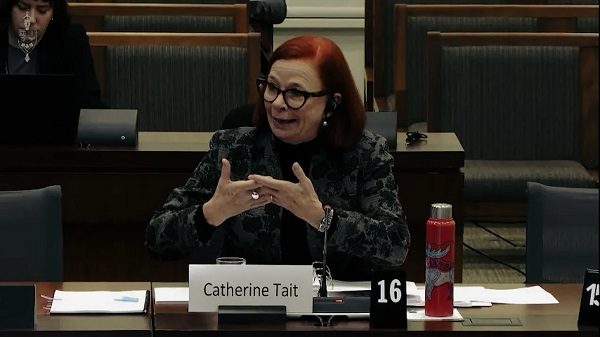Opinion
CBC on Trial: CBC CEO Catherine Tait Faces Brutal Takedown in Canadian Heritage Committee Hearing

Catherine Tait defends executive bonuses, taxpayer funding, and the CBC’s relevance as MPs demand accountability and question its future.
Monday’s session of the Standing Committee on Canadian Heritage was nothing short of a political brawl, as Catherine Tait, President and CEO of the Canadian Broadcasting Corporation, came under relentless fire for her management of the public broadcaster. It was a hearing that stripped away the thin veneer of CBC’s claims to be a unifying institution and exposed it for what it truly is—a bloated, taxpayer-funded bureaucracy that’s out of touch with the very Canadians it’s supposed to serve.
From the outset, this was a fight Tait couldn’t win. She walked into the committee room, 197 Sparks Street in Ottawa, armed with prepared talking points about digital growth and Canadian culture. But those defenses crumbled under the weight of hard-hitting questions from Conservative MPs who weren’t interested in excuses.
MP Damien Kurek opened the proceedings with a scathing indictment of CBC’s financial priorities, taking aim at the $18 million in executive bonuses awarded during a period of layoffs and budget shortfalls.
“Last time the CBC asked for taxpayer money, it went to bonuses,” Kurek declared. “At a time when people are being laid off, will you categorically reject any bonus offered to you as your tenure comes to a close?”
Tait’s response? Pure bureaucratic double-speak. She claimed the bonuses were a “contractual obligation” and part of normal payroll operations, as if that somehow justified lining executive pockets with taxpayer dollars while ordinary Canadians struggle. “Performance pay is part of the annual salary calculation,” Tait said, skirting the core issue of accountability.
But Kurek wasn’t alone. Andrew Scheer, former Conservative leader, delivered perhaps the most devastating blows later in the hearing. With his characteristic precision, Scheer called out CBC’s declining public trust, sagging viewership, and mismanagement of taxpayer funds.
“You talk about digital growth, but that doesn’t change the fact that more and more Canadians want the CBC defunded. What does that tell you about how disconnected your organization is from the people you claim to serve?”
Tait’s attempt to counter these accusations with claims of digital engagement and cultural contributions only highlighted how out of touch the CBC leadership is. “While traditional TV viewership may be declining, our digital platforms have grown significantly, reaching millions of Canadians monthly,” she insisted. But for Scheer and millions of Canadians, that’s not the point. It’s not about clicks and digital revenue; it’s about trust, and the CBC has lost it.
The Liberal MPs, as expected, rushed to Tait’s defense. Michael Coteau accused the Conservatives of ideological warfare against the CBC, framing the broadcaster as a national treasure under siege.
“The conservatives seem intent on destroying one of the last institutions uniting Canadians,” Coteau said, conveniently ignoring that the CBC has alienated much of the country with its political bias and inefficiency.
Meanwhile, the Bloc Québécois focused on preserving Radio-Canada, the French-language arm of the CBC, warning that defunding the English side would have catastrophic effects on Francophone programming. Bloc MP Martin Champoux pressed Tait on how funding cuts could exacerbate public frustrations with ads and digital barriers, only for Tait to suggest the solution was—of course—more taxpayer money. “Replacing commercial revenue would require an additional $400 to $500 million from taxpayers,” she explained.
Even the NDP, usually allies of big government, expressed frustration. Niki Ashton blasted the CBC for handing out bonuses while neglecting rural and northern Canada. She demanded accountability:
“Canadians want to see a public broadcaster that is accountable to them, not doling out executive bonuses while cutting jobs and neglecting regional stories.”
The hearing wasn’t just about dollars and cents; it was about whether the CBC still has a place in Canada’s media landscape. For decades, CBC defenders have painted it as a vital cultural institution, a unifying force in a diverse nation. But the reality laid bare in Monday’s hearing is starkly different: a taxpayer-funded broadcaster that prioritizes executive perks over public service, that alienates rural and conservative Canadians while cozying up to elites, and that spends more time justifying its existence than fulfilling its mandate.
And let’s be honest, that’s the CBC’s real problem—it’s not just bloated and wasteful; it’s arrogant. Catherine Tait sits there, comfortable on her half-a-million-dollar salary, doling out millions in bonuses, all while Canadians are told they need the CBC to “unite” them. But unite them how? By force-feeding them narratives they don’t trust, all at their own expense?
Here’s the truth: the CBC doesn’t unite Canadians. It alienates them. And every taxpayer dollar it demands only widens the gap. The time for excuses is over. It’s time for accountability.
Maybe we should defund the CBC. Not because it’s out of touch, though it is. Not because it’s failing, though it clearly is. But because Canadians deserve better than to bankroll a broadcaster that no longer respects them, represents them, or serves them. Defunding the CBC isn’t the end of Canadian culture—it’s the start of giving it back to the people.
Opinion
Globally, 2025 had one of the lowest annual death rates from extreme weather in history

Congratulations World!
Here at THB we are ending 2025 with some incredibly good news that you might not hear about anywhere else — Globally, 2025 has had one of the lowest annual death rates from disasters associated with extreme weather events in recorded history.¹
According to data from the Centre for Research on the Epidemiology of Disasters (CRED) at the Université Catholique de Louvain, Belgium (via Our World in Data), through October 2025, the world saw about 4,500 deaths related to extreme weather events.² Tragically, the final two months of 2025 saw large loss of life related to flooding in South and Southeast Asia, associated with Cyclones Senyar and Ditwah.
While the final death tolls are not yet available, reports suggest perhaps 1,600 people tragically lost their lives in these and several other events in the final two months of the year.
If those estimates prove accurate, that would make 2025 among the lowest in total deaths from extreme weather events. Ever! I am cautious here because the recent decade or so has seen many years with similarly low totals — notably 2014, 2015, 2016, 2018, 2021.
What we can say with some greater confidence is that the death rate from extreme weather events is the lowest ever at less than 0.8 deaths per 100,000 people (with population data from the United Nations). Only 2018 and 2015 are close.
To put the death rate into perspective, consider that:
- in 1960 it was >320 per 100,000;
- in 1970, >80 per 100,000;
- in 1980, ~3 per 100,000;
- in 1990, ~1.3 per 100,000;
Since 2000, six years have occurred with <1.0 deaths per 100,000 people, all since 2014. From 1970 to 2025 the death rate dropped by two orders of magnitude. This is an incredible story of human ingenuity and progress.
To be sure, there is some luck involved as large losses of life are still possible — For instance, 2008 saw almost 150,000 deaths and a death rate of ~21 per 100,000. Large casualty events remain a risk that requires our constant attention and preparation.
But make no mistake, 2025 is not unique, but part of a much longer-term trend of reduced vulnerability and improved preparation for extreme events. Underlying this trend lies the successful application of science, technology, and policy in a world that has grown much wealthier and thus far better equipped to protect people when, inevitably, extreme events do occur.
Bravo World!
Learn more:
Formetta, G., & Feyen, L. (2019). Empirical evidence of declining global vulnerability to climate-related hazards. Global Environmental Change, 57, 101920.
1
What is “recorded history”? CRED says their data is robust since 2000, as their dataset did not have complete global coverage and perviously many events went unreported. That means that the tabulations of CRED prior to 2000 are with high certainty undercounts of actual deaths related to extreme weather events.
2
Note that extreme temperature event impacts (cold and hot) are not included here — Not becaue they are not a legitimate focus, but because tracking such events has only begun in recent years, and methodologies are necessarily different when it comes to accounting for the direct loss of life related to storms and floods (e.g., epidemiological mortality vs. actual mortality). See a THB discussion of some of these issues here. My recommendation is to account for extreme temperature impacts in parallel to impacts from events like hurricanes, floods, and tornadoes — Rather than trying to combine apples and oranges.
Addictions
Coffee, Nicotine, and the Politics of Acceptable Addiction

From the Brownstone Institute
By
Every morning, hundreds of millions of people perform a socially approved ritual. They line up for coffee. They joke about not being functional without caffeine. They openly acknowledge dependence and even celebrate it. No one calls this addiction degenerate. It is framed as productivity, taste, wellness—sometimes even virtue.
Now imagine the same professional discreetly using a nicotine pouch before a meeting. The reaction is very different. This is treated as a vice, something vaguely shameful, associated with weakness, poor judgment, or public health risk.
From a scientific perspective, this distinction makes little sense.
Caffeine and nicotine are both mild psychoactive stimulants. Both are plant-derived alkaloids. Both increase alertness and concentration. Both produce dependence. Neither is a carcinogen. Neither causes the diseases historically associated with smoking. Yet one has become the world’s most acceptable addiction, while the other remains morally polluted even in its safest, non-combustible forms.
This divergence has almost nothing to do with biology. It has everything to do with history, class, marketing, and a failure of modern public health to distinguish molecules from mechanisms.
Two Stimulants, One Misunderstanding
Nicotine acts on nicotinic acetylcholine receptors, mimicking a neurotransmitter the brain already uses to regulate attention and learning. At low doses, it improves focus and mood. At higher doses, it causes nausea and dizziness—self-limiting effects that discourage excess. Nicotine is not carcinogenic and does not cause lung disease.
Caffeine works differently, blocking adenosine receptors that signal fatigue. The result is wakefulness and alertness. Like nicotine, caffeine indirectly affects dopamine, which is why people rely on it daily. Like nicotine, it produces tolerance and withdrawal. Headaches, fatigue, and irritability are routine among regular users who skip their morning dose.
Pharmacologically, these substances are peers.
The major difference in health outcomes does not come from the molecules themselves but from how they have been delivered.
Combustion Was the Killer
Smoking kills because burning organic material produces thousands of toxic compounds—tar, carbon monoxide, polycyclic aromatic hydrocarbons, and other carcinogens. Nicotine is present in cigarette smoke, but it is not what causes cancer or emphysema. Combustion is.
When nicotine is delivered without combustion—through patches, gum, snus, pouches, or vaping—the toxic burden drops dramatically. This is one of the most robust findings in modern tobacco research.
And yet nicotine continues to be treated as if it were the source of smoking’s harm.
This confusion has shaped decades of policy.
How Nicotine Lost Its Reputation
For centuries, nicotine was not stigmatized. Indigenous cultures across the Americas used tobacco in religious, medicinal, and diplomatic rituals. In early modern Europe, physicians prescribed it. Pipes, cigars, and snuff were associated with contemplation and leisure.
The collapse came with industrialization.
The cigarette-rolling machine of the late 19th century transformed nicotine into a mass-market product optimized for rapid pulmonary delivery. Addiction intensified, exposure multiplied, and combustion damage accumulated invisibly for decades. When epidemiology finally linked smoking to lung cancer and heart disease in the mid-20th century, the backlash was inevitable.
But the blame was assigned crudely. Nicotine—the named psychoactive component—became the symbol of the harm, even though the damage came from smoke.
Once that association formed, it hardened into dogma.
How Caffeine Escaped
Caffeine followed a very different cultural path. Coffee and tea entered global life through institutions of respectability. Coffeehouses in the Ottoman Empire and Europe became centers of commerce and debate. Tea was woven into domestic ritual, empire, and gentility.
Crucially, caffeine was never bound to a lethal delivery system. No one inhaled burning coffee leaves. There was no delayed epidemic waiting to be discovered.
As industrial capitalism expanded, caffeine became a productivity tool. Coffee breaks were institutionalized. Tea fueled factory schedules and office routines. By the 20th century, caffeine was no longer seen as a drug at all but as a necessity of modern life.
Its downsides—dependence, sleep disruption, anxiety—were normalized or joked about. In recent decades, branding completed the transformation. Coffee became lifestyle. The stimulant disappeared behind aesthetics and identity.
The Class Divide in Addiction
The difference between caffeine and nicotine is not just historical. It is social.
Caffeine use is public, aesthetic, and professionally coded. Carrying a coffee cup signals busyness, productivity, and belonging in the middle class. Nicotine use—even in clean, low-risk forms—is discreet. It is not aestheticized. It is associated with coping rather than ambition.
Addictions favored by elites are rebranded as habits or wellness tools. Addictions associated with stress, manual labor, or marginal populations are framed as moral failings. This is why caffeine is indulgence and nicotine is degeneracy, even when the physiological effects are similar.
Where Public Health Went Wrong
Public health messaging relies on simplification. “Smoking kills” was effective and true. But over time, simplification hardened into distortion.
“Smoking kills” became “Nicotine is addictive,” which slid into “Nicotine is harmful,” and eventually into claims that there is “No safe level.” Dose, delivery, and comparative risk disappeared from the conversation.
Institutions now struggle to reverse course. Admitting that nicotine is not the primary harm agent would require acknowledging decades of misleading communication. It would require distinguishing adult use from youth use. It would require nuance.
Bureaucracies are bad at nuance.
So nicotine remains frozen at its worst historical moment: the age of the cigarette.
Why This Matters
This is not an academic debate. Millions of smokers could dramatically reduce their health risks by switching to non-combustion nicotine products. Countries that have allowed this—most notably Sweden—have seen smoking rates and tobacco-related mortality collapse. Countries that stigmatize or ban these alternatives preserve cigarette dominance.
At the same time, caffeine consumption continues to rise, including among adolescents, with little moral panic. Energy drinks are aggressively marketed. Sleep disruption and anxiety are treated as lifestyle issues, not public health emergencies.
The asymmetry is revealing.
Coffee as the Model Addiction
Caffeine succeeded culturally because it aligned with power. It supported work, not resistance. It fit office life. It could be branded as refinement. It never challenged institutional authority.
Nicotine, especially when used by working-class populations, became associated with stress relief, nonconformity, and failure to comply. That symbolism persisted long after the smoke could be removed.
Addictions are not judged by chemistry. They are judged by who uses them and whether they fit prevailing moral narratives.
Coffee passed the test. Nicotine did not.
The Core Error
The central mistake is confusing a molecule with a method. Nicotine did not cause the smoking epidemic. Combustion did. Once that distinction is restored, much of modern tobacco policy looks incoherent. Low-risk behaviors are treated as moral threats, while higher-risk behaviors are tolerated because they are culturally embedded.
This is not science. It is politics dressed up as health.
A Final Thought
If we applied the standards used against nicotine to caffeine, coffee would be regulated like a controlled substance. If we applied the standards used for caffeine to nicotine, pouches and vaping would be treated as unremarkable adult choices.
The rational approach is obvious: evaluate substances based on dose, delivery, and actual harm. Stop moralizing chemistry. Stop pretending that all addictions are equal. Nicotine is not harmless. Neither is caffeine. But both are far safer than the stories told about them.
This essay only scratches the surface. The strange moral history of nicotine, caffeine, and acceptable addiction exposes a much larger problem: modern institutions have forgotten how to reason about risk.
-

 Alberta2 days ago
Alberta2 days agoThe Canadian Energy Centre’s biggest stories of 2025
-

 Business19 hours ago
Business19 hours agoDark clouds loom over Canada’s economy in 2026
-

 Business19 hours ago
Business19 hours agoThe Real Reason Canada’s Health Care System Is Failing
-

 Business2 days ago
Business2 days agoOttawa Is Still Dodging The China Interference Threat
-

 Business2 days ago
Business2 days agoResurfaced Video Shows How Somali Scammers Used Day Care Centers To Scam State
-

 Addictions16 hours ago
Addictions16 hours agoCoffee, Nicotine, and the Politics of Acceptable Addiction
-

 Business2 days ago
Business2 days agoMinneapolis day care filmed empty suddenly fills with kids
-

 Business2 days ago
Business2 days agoDisclosures reveal Minnesota politician’s husband’s companies surged thousands-fold amid Somali fraud crisis













